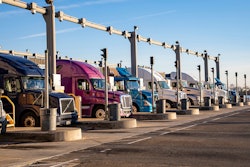
As used truck values soar, there’s hope that the Federal Reserve’s interest rate hikes will help to bring down costs.
On Wednesday, the short-term interest rate was increased by .50%, the biggest single hike in more than 20 years.
Corcentric Senior Vice President of supply management Rob Garcia sees growing interest rates as way to bring down asset costs, which have soared at a historic pace.
“That should help us correct a lot of this tremendous asset inflation,” Garcia said during an equipment and supply chain outlook panel at a recent Corcentric Fleet Maintenance Conference in Charlotte, N.C.
[Related: Freight market looks strong despite sagging spot rates]
Used truck prices in particular have had astronomical gains over the past year.
“It’s effectively double,” Dale Tower, vice president of used trucks at AmeriQuest, a Corcentric subsidiary, said during the panel.
“In some cases, some specialty equipment has gone up even higher – like medium duty trucks, especially 26 footers," he said. "Non-CDL [trucks] have probably gone up two and a half times where they were 18 months ago."
Used trailers prices “have pretty much tripled,” Tower continued. “The example a gentleman gave on a 10-year-old trailer being double what it was built for is really incredible. It’s been astronomical. I’ve been in the business a long time and, yes, there are shifts. We have cyclical shifts in the value of equipment all the time but it’s never shifted this much.”
 Panelists at a Corcentric fleet maintenance conference held last week in Charlotte, N.C. are from left to right: Dale Tower, vice president of AmeriQuest used trucks; Sean Storey, Corcentric vice president of capital equipment; and Rob Garcia, Corcentric senior vice president of supply management. They're joined by moderator Jessica Green, Corcentric director of supplier marketing.
Panelists at a Corcentric fleet maintenance conference held last week in Charlotte, N.C. are from left to right: Dale Tower, vice president of AmeriQuest used trucks; Sean Storey, Corcentric vice president of capital equipment; and Rob Garcia, Corcentric senior vice president of supply management. They're joined by moderator Jessica Green, Corcentric director of supplier marketing.
“I think what you're going to see is a repeat from this year to next. It’s not going to get much better,” Storey said. “Most of your OEMs are not running at capacity. They're building as much as they can, but there are things hurting them with supply chain disruption.”
An ongoing microchip shortage is only part of the problem.
“We've all heard about semiconductors causing most of the problems to start with, but [OEMs] are seeing more and more problems with other components that they just can't get in sufficient quantities,” Storey said.
“The other factor that's disrupting what they're doing is labor,” Storey continued. “Ever since COVID hit, they had problems with people who were happy to sit at home and collect a check and not go to work.”
As high prices and equipment constraints continue, Garcia recommends stepping up fleet maintenance.
“Preserve the commercial vehicles that you have – absolutely preserve them,” he said. “The value of those current vehicles is just rising – amazingly, amazingly rising, 100% mark-up in some instances.
“The fact that you can't replace [equipment] effectively, new vehicles aren’t being produced fast enough to replace your existing vehicles and the fact that there's so much freight out there to move, you need these vehicles running,” Garcia continued. “You need that uptime so you really need to spend the money. The maintenance is so important on these vehicles. More important than ever.”
Shifting to a multi-supplier approach is also advised.
"Embrace multiple suppliers," Garcia said. "It's hard to commit to any one supplier anymore only for the fact that they just don't have enough product. So you're going to have to go to multiple suppliers. Talk to them. Talk to them about the needs that you have."
Garcia also recommends that fleets keep rising taxes in mind under the Biden administration.
“The whole taxation plan of this current administration hasn't really even taken effect yet,” Garcia said. “There's a lot of talk around tax, which is just another increasing cost, basically, that would have to be pushed down to all levels of the supply chain, including the end customers.”











